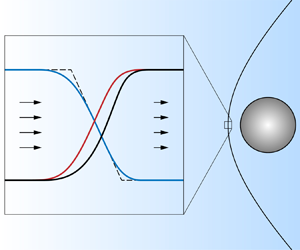No CrossRef data available.
Article contents
A comprehensive study on the roles of viscosity and heat conduction in shock waves
Published online by Cambridge University Press: 12 April 2024
Abstract

Shock waves are of great interest in many fields of science and engineering, but the mechanisms of their formation, maintenance and dissipation are still not well understood. While all transport processes existing in a shock wave contribute to its compression and irreversibility, they are not of equal importance. To figure out the roles of viscosity and heat conduction in shock transition, the existence of smooth shock solutions and the counter-intuitive entropy overshoot phenomenon (the specific entropy is not monotonically increasing and exhibits a peak inside the shock front) are theoretically and numerically investigated, with emphasis on the effects of viscosity and heat conduction. Instead of higher-order hydrodynamics, the Navier–Stokes formalism is employed for its stability and simplicity. Supplemented with nonlinear thermodynamically consistent constitutive relations, the Navier–Stokes equations are adequate to demonstrate the general nature of shock profiles. It is found that heat conduction cannot sustain strong shocks without the presence of viscosity, while viscosity can maintain smooth shock transition at all strengths, regardless of heat conduction. Hence, the critical role in shock compression is played by viscosity rather than heat conduction. Nevertheless, the dispensability of heat conduction would not compromise its essential role in the emergence of an entropy peak. It is the entropy flux resulting from heat conduction that neutralises the positive entropy production and thus prevents the decreasing entropy from violating the second law of thermodynamics. This mechanism of entropy overshoot has not been addressed previously in the literature and is revealed using the entropy balance equation.
- Type
- JFM Papers
- Information
- Copyright
- © The Author(s), 2024. Published by Cambridge University Press





